A marvel of engineering, when completed ITER is intended for the first time to demonstrate large-scale net energy production by fusion reactions and provide the last stepping-stone to a prototype fusion power plant.
But from the outset the mind-boggling size and complexity of the system should have sounded alarm bells. Also the danger of creating a bureaucratic monster.
Since its construction began in 2010, ITER has been plagued by a virtually endless series of problems and delays, pushing the target date for completion back again and again. The reactor was originally supposed to go on line in 2016, but today construction is still ongoing.
The last official target was 2025. But in November 2022, the newly appointed ITER Director Pietro Barabaschi informed the public that the target date of 2025 was no longer realistic, and that additional problems had emerged, whose resolution would be“not a question of weeks, but months, even years.”
Last year defects were reported in two of the most important components of the reactor: the sector plates that are to be welded together to form the vacuum vessel of the reactor (its“combustion chamber”) and the reactor's thermal shielding.
The French Nuclear Safety Authority ordered a halt to assembly of the vacuum vessel after discovering misalignments between the welding surfaces of the first two 440-ton vessel sections. These apparently had been damaged in transit from South Korea, where they were manufactured. Reportedly, the defects in the thermal shielding of the reactor will require removal and replacement of 23 kilometers of cooling pipes.
Difficulties of this sort are not unheard of in projects with many first-of-the-kind features. But when they come on top of an endless series of hitches and delays in ITER's decades'-long history, one can only regard the project as a fiasco.
The ITER might yet have a happy end, but it will be different from the one originally intended. Even assuming operation were to begin in 2025, the official ITER scenario foresees an additional 10 years of experiments before the reactor begins operating with fusion-reaction-generating deuterium-tritium fuel.
If all goes well, it might take another five-to-10 years before ITER achieves the promised goal of a ten-fold“return on power” (500 MW of fusion power from 50 MW of input heating power).
Even then, ITER is designed not to generate electricity but only to lay the basis for constructing a first prototype electricity-generating fusion power plant – referred to as the“DEMO.” If successful, the“DEMO” would then provide the jumping-off point for commercial fusion plants, which might go on line early in the second half of this century.
Needless to say, this scenario – if realizable at all – is intolerably long.
Ironically, I am convinced that the ITER fiasco will actually accelerate, rather than slow down, progress toward the practical realization of fusion power.
On the background of the world's energy and environmental challenges, it is spurring governments and private capital to invest more in alternative scenarios which – taken together – hold the promise of realizing commercially viable fusion power on a far shorter timescale.
One indication is accelerated plans by China and Japan to build their own national“DEMO” plants, without necessarily waiting for the results of ITER to come in. Both nations have reactor projects underway, which could in effect substitute for the role of ITER and accelerate development on the basis of knowledge and technologies that did not exist when the final design of ITER was approved, in 2001.
South Korea is designing a“K-DEMO” reactor, intended to generate approximately 2.2 GW of thermal power and supply over 500 MW to the electricity grid.
As these nations are participants in ITER, pronouncements concerning national DEMO reactors still present them, diplomatically, as successors to the ITER project. But there is an obvious effort to find ways to skip over the endless wait for ITER to go on line while, at the same time, drawing on the theoretical and experimental work carried out under the umbrella of ITER.
Unfortunately, in my view, the plans of various nations to build DEMO reactors all embrace the same basic model as the ITER: They are all giant, scaled-up tokamak devices.
Drawing on 70 years of experience with tokamak reactors, this ultraconservative approach has low risk as far as producing large net amounts of fusion energy is concerned – but a very high risk of ending up with systems that are useless as models for commercially viable power plants.
The latter risk can only be avoided by introducing revolutionary innovations into the“classical” tokamak approach, or shifting to alternative designs.
Latest stories

'collective ambiguity' on taiwan needs shoring up

marcos squeezed between allies

intel expands in china despite sanctions
The realization that the ITER scenario is a long blind alley, as far as commercially viable power production is concerned, no doubt is a factor contributing to the unprecedented flood of private capital into alternative fusion technologies. These range from compact high-field tokamaks to revolutionary designs such as Helion Energy's magneto-inertial fusion reactor and ultrashort-pulse laser-driven proton-boron reactors.
The last 3 years have seen over $4 billion in private money flow into fusion – more than the US government spent for all civilian fusion activities in the same period.
Naturally, investor enthusiasm has been further encouraged by the reported achievement, in December 2022 of“scientific breakeven” in laser fusion experiments at the US National Ignition Facility. Although this achievement constitutes more a milestone than a real breakthrough, it has transformed the public perception of fusion, conveying a sense that fusion power is in the process of becoming a concrete reality rather than a mere remote possibility.
It is worth noting that the rapid growth of the private fusion industry would have been impossible if fusion“old-timers” had not emigrated from government labs into the private sector, carrying invaluable expertise and ideas with them.
In many cases the privately-funded projects are outgrowths of experiments on promising alternative reactor types, originally carried out in government-sponsored labs but then cast aside in the context of budget-cutting and the growing priority given to the“big tokamak” approach to fusion, leading to ITER.
Background In my view, the ITER project was ill-conceived from the beginning, predestined more to hinder than to promote the speedy realization of fusion power. Among other things, the preeminent status accorded to ITER in international fusion research has provided an excuse for defunding work in other directions.
Adopting the unwise policy of“putting all the eggs in one basket”, the US and the European Union have come to regard participation in ITER as a substitute for pursuing independent programs on a national level. Presently the largest part of government support for fusion research worldwide goes to activities connected with the ITER project.
From the start ITER was closely linked with high-level international politics, which is not conducive to unbiased decision-making.
The concept of an international project to develop fusion energy for peaceful purposes was raised at the famous Geneva summit meeting between President Ronald Reagan and Soviet General Secretary Mikhail Gorbachev in November 1985 and included in their joint statement.
The idea was concretized in a 1986 agreement by the US, USSR, EU and Japan to design jointly a large fusion reactor. Later China, the Republic of Korea and India joined the project.

11/19/1985 President Reagan and Soviet General Secretary Gorbachev at the first summit in Geneva, Switzerland, November 19, 1985. Photo: Wikimedia Commons
Unfortunately, the decision in favor of building a“classical” tokamak reactor of gigantic dimensions came about under the influence of a powerful lobby within the fusion community, at the expense of a broad-based pursuit of alternative approaches. Politically speaking, a single spectacular endeavor is more attractive than a“faceless” research program however well-conceived.
Granted, there is a reason to expect that ITER, once completed, will eventually succeed in achieving a large net production of thermal energy by fusion reactions. It is highly implausible, however, that a system of this size and complexity could ever become a commercially viable source of energy.
Here it is important to keep in mind that – contrary to its public image – the primary mission of ITER was not to serve as a realistic model for commercial fusion power plants, but rather to generate scientific knowledge and to develop and test components and technology judged important for the future design of power-producing fusion reactors.
Unfortunately, the decade-long delays have greatly reduced ITERs relevance to the ongoing fusion race. And by the time ITER goes on line, it will be obsolete in many respects.

ITER reactor construction site in 2018. Photo: Wikimedia Commons
Recall again the history of the ITER project: Conceptual design work on the reactor began in 1988, followed by a series of engineering design phases with the final design approved 15 years later, in 2001.
In the meantime fusion-related science and technology has progressed enormously. If one were to design the same sort of reactor today, it nearly certainly would look quite different.
This would not have been so problematic if the reactor had gone on line in 2016. But today, two decades after the final design, the reactor is still not finished and the projected total cost has increased many times over, reaching a figure variously estimated as between 22 and 50 billion dollars.
Chronic underfunding of fusion That may sound like a great deal of money, but even taking the cost-explosion of ITER into account, fusion research has long been underfunded in relation to its importance for tomorrow's world. Ironically, the ITER fiasco is to a considerable extent a product of this chronic underfunding.
Currently US government support for fusion research – including both magnetic and inertial confinement fusion – amounts to less than 0.005% of GDP. At its highest point, in the early 1980s, the fusion budget corresponded to approximately 0.008% of GDP.
The difference is more significant than the mere figures would indicate, however. In contrast to today, up to the middle of the 1980s the U.S. government had funded a wide array of different approaches to fusion in addition to“classical” tokamak and laser fusion. Indeed, fusion – in contrast to fission – can in principle be realized in a great variety of different ways.
But starting around 1985 – the same year as the Reagan-Gorbachev summit – the US fusion budget was drastically reduced. The program was progressively“thinned out.” Projects were defunded, one after the other, and even shut down outright.
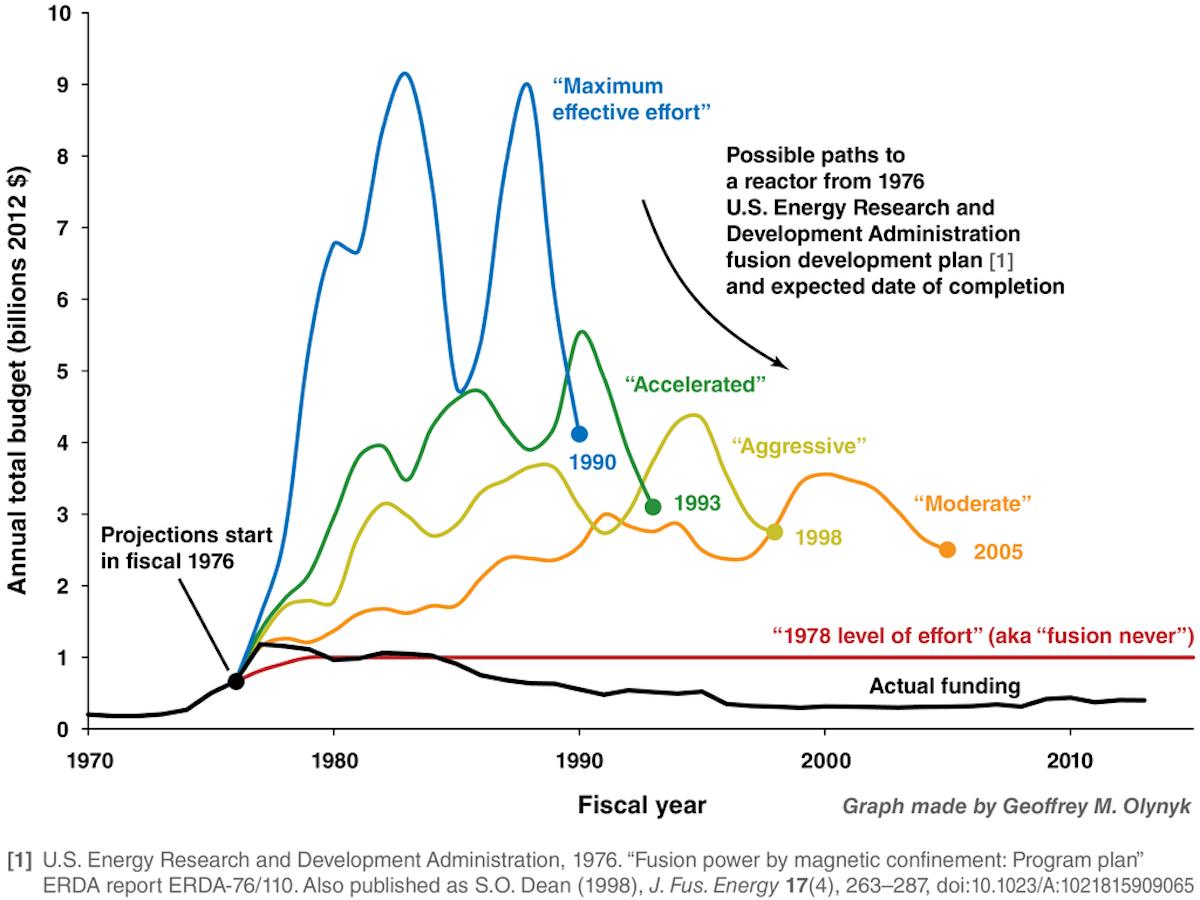
Graph comparing the U.S. government magnetic confinement fusion research budget to five funding scenarios from the 1976 Energy Research and Development Administration fusion development plan, with actual government funding through 2011. Image: Wikimedia Commons
(In this article I concentrate on magnetic confinement fusion. The domain of inertial confinement, of which laser fusion is only the most well-known example, was also subjected to a disastrous“thinning out” process. That story runs on a separate track, and I shall not go into it here.)
A horrifying example of thinning out is the fate of the Mirror Fusion Test Facility (MFTF) at Lawrence Livermore National Laboratory, a promising magnetic confinement fusion device with a configuration radically different from that of a tokamak.
The MFTF project was shut down in 1986 – on the very same day the construction of the reactor was completed. With no operating budget, the staff members lost their jobs overnight. No experiments were carried out on the device, which had cost the equivalent of over $1 billion in current dollars to build.
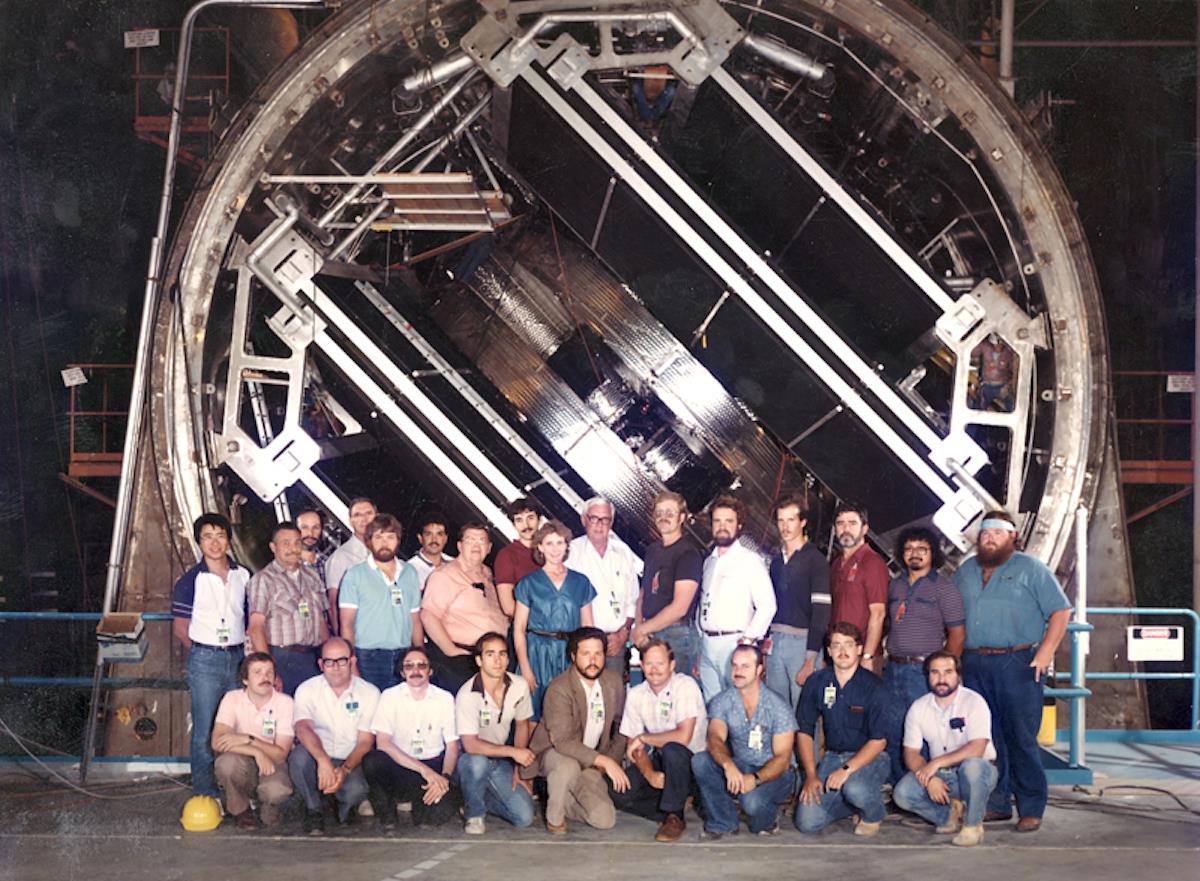
The Mirror Fusion Test Facility (MFTF) under construction at the Lawrence Livermore National Laboratory (December 1983). Photo? Wikimedia Commons
In 1997 budget cuts led to the premature shutdown of the Tokamak Fusion Test Reactor (TFTR), which had achieved record levels of fusion power generation. Two years before its shutdown, TFTR also achieved a world-record temperature of 510 million °C.
Fortunately, the results gained in 15 years of operation served as a basis for subsequent devices, such as Japan's JT-60.

The TFTR fusion reactor at the Princeton Plasma Physics Laboratory (1989). Photo: Wikipedia
A more recent case is the -Mod reactor at MIT, a tokamak device radically different from tokamaks of the“classical” type and characterized by compact size and extremely high magnetic fields. This device was the latest in a whole series of devices, going back to the early 1970s, based on the work of the brilliant Italo-American physicist Bruno Coppi. Although extremely successful – having achieved the world record for plasma pressure in a magnetic confinement device, for example – Alcator C was shut down in 2016 with no follow-on project.
Fortunately work on compact high-field tokamak approach has been taken up again, with the help of private capital, by the company Commonwealth Fusion. I have written about the current project in an earlier article ( ).
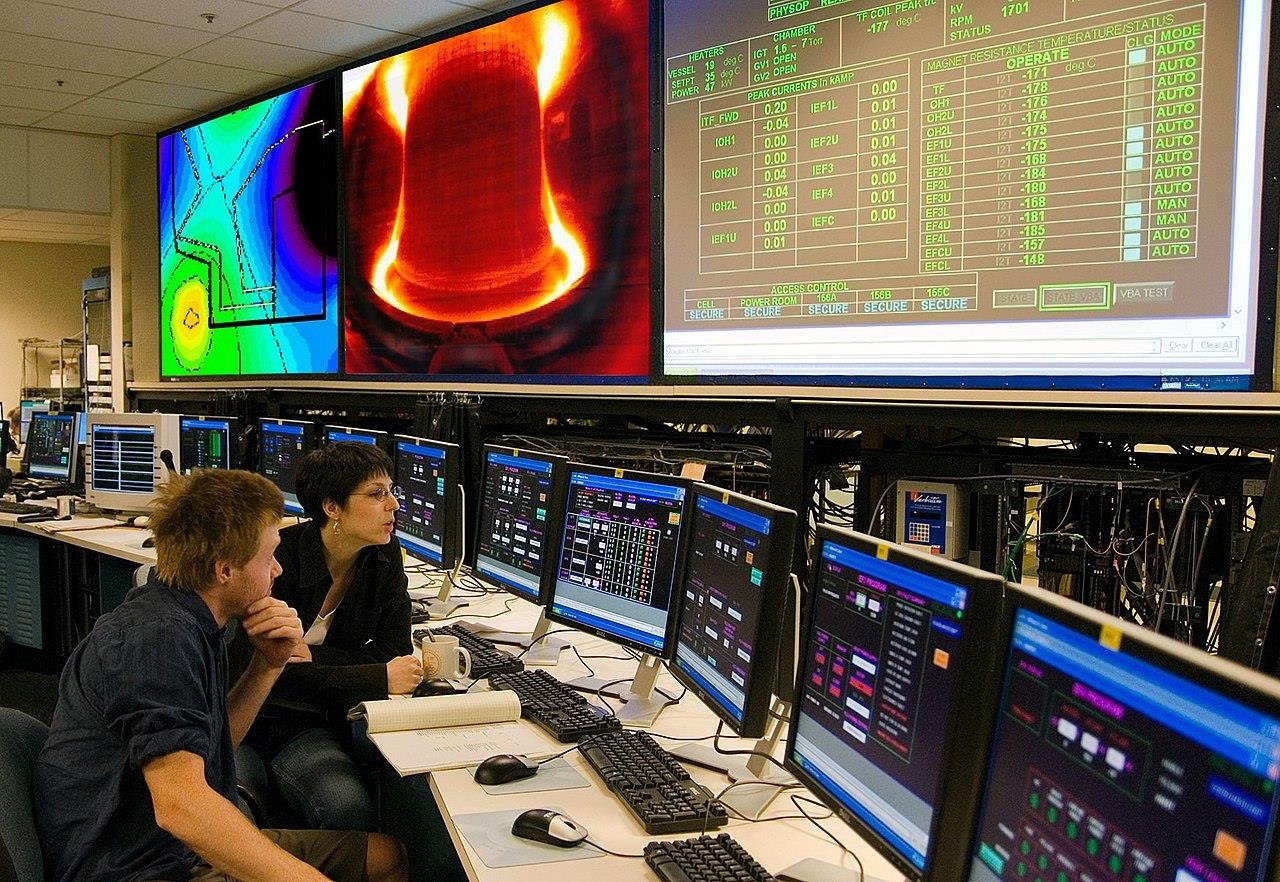
MIT graduate students in the Alcator C-Mod control room (2008). Photo: Wikimedia Commons
The policy of the US, European and other governments, to put all (or most) of their eggs into the single ITER basket, is both a result and a cause of abandoning a broad-based approach to realizing fusion, which would include adequate funding for both“mainline” and alternative approaches.
ITER's difficulties are no cause for pessimism Some skeptics will point to the difficulties of ITER as further evidence that fusion power is at best a very distant prospect – or even not realizable at all. This is nonsense.
Since the late 1960s, thanks to decades of work on dozens of tokamak devices, the experimentally achieved value of the so-called fusion triple product – the crucial parameter measuring progress toward net energy generation by fusion reactions – has doubled on average every 1.8 years. That is even faster than the famous“Moore's Law” for the development of semiconductor chips.
In the early decades of fusion research, the triple product was many orders of magnitude below the minimum level for so-called scientific breakeven (more energy released from fusion reactions than input energy from plasma heating systems).
Today, experimental reactors have come to within a factor of 10 of the threshold value. If the doubling trend continues – and there is no reason to think it cannot – the threshold value will likely be exceeded in a few years and the higher values required for viable power production will be only another few years away.
Naturally this assumes well-funded, broad-based efforts by the leading fusion nations, involving a multitude of devices, as opposed to“putting all the eggs in one basket.”
Meanwhile, the generation of substantial amounts of energy by fusion reactions, at multimegawatt power levels, was demonstrated already back in the 1990s by the two tokamak reactors: the Tokamak Fusion Test Reactor (TFTR) at Princeton and the Joint European Torus (JET) in Culham, England.
In 1997 JET generated a record 16 MW of fusion power from deuterium-tritium (DT) reactions at temperatures of 100-150 million degrees. The input heating power was larger – about 24 MW – but the system thereby came to within a factor of 1.5 of scientific breakeven. In 2022 JET produced a record energy output of 60 megajoules, at an average power level of 11 megawatts.
Today a number of tokamak experimental devices, such as china's east , operate routinely at temperatures of 100 million degrees and higher, sufficient for“burning” DT fuel. Currently, most of them are conducting experiments without tritium, in order to avoid large neutron radiation and the need for tritium handling. Otherwise the previous records surely would have been exceeded by now.
Naturally these remarks do not constitute“proof” that viable fusion power plants can soon become a reality. But they give reasons to be skeptical about the skeptics.
The future of ITER

Aerial view of ITER site imn 2020. Photo: Wikimedia Commons
I am not suggesting that the ITER project – which is approximately 80% finished – should be abandoned. But it will be necessary to shift priorities and redefine the role of ITER in the context of the global fusion effort.
What must be abandoned, above all, is the scenario according to which ITER would serve as the basis for constructing a prototype electricity-generating fusion power plant. It is practically certain that such plants will be completely different from ITER.
n for fusion reactors.
Granted, fusion research is costly, the ITER project excessively so. But rather than complaining about the expense, governments should ask themselves: isn't it worth investing a few thousandths of a single year's GNP in order to create an unlimited energy source?
Jonathan Tennenbaum (PhD, mathematics) is a former editor of FUSION magazine and has written on a wide variety of topics in science and technology, including several books on nuclear energy. He is also an international collaborator of the Institute for the Philosophy and History of Science at the University of Lisbon, working on alternative approaches to quantum physics.
Like this:Like Loading... Related



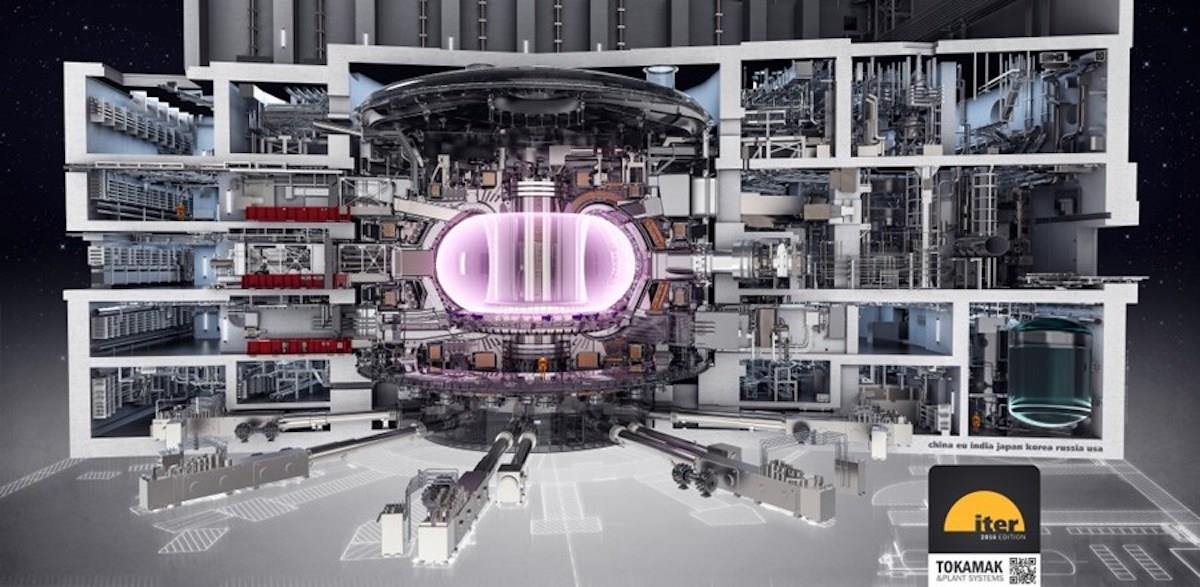
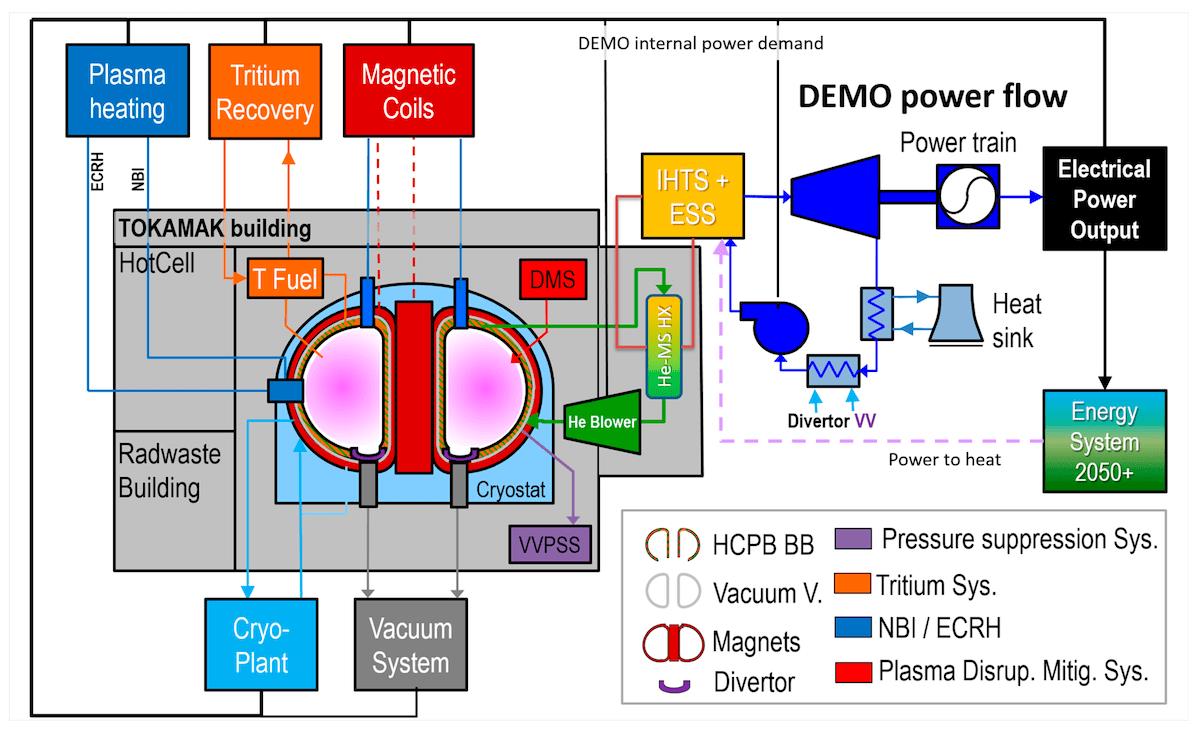


























Comments
No comment